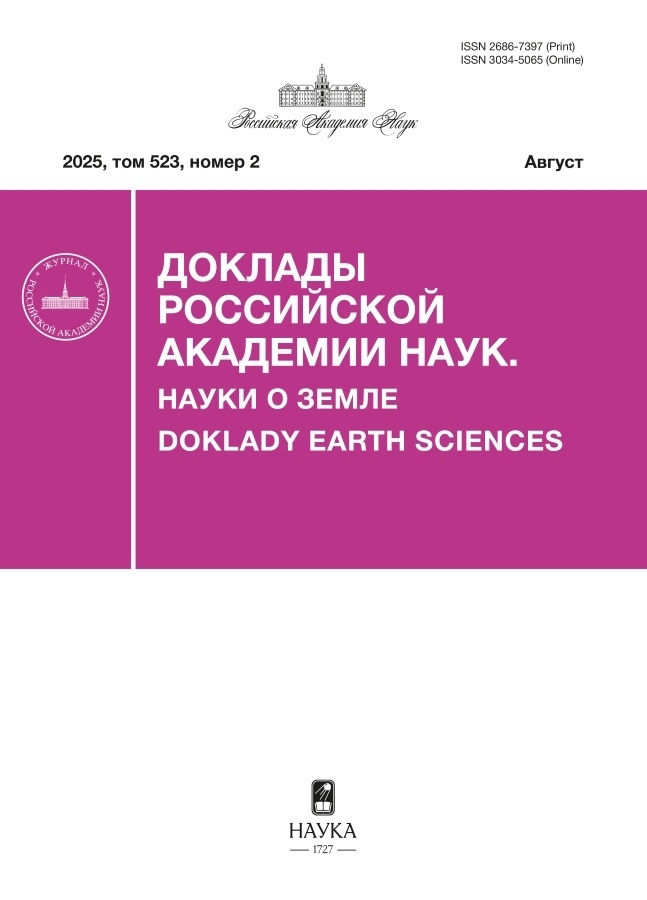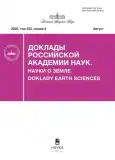Forecast of seismic and geodynamic conditions before and after the earthquake of March 28, 2025, M7.7, in Myanmar
- Authors: Baranov S.V.1,2, Vinberg F.E.1, Vladimirova I.S.1,3, Vorobieva I.A.1, Kosobokov V.G.1, Krushelnitskii K.V.1, Matochkina S.D.1, Nekrasova A.K.1, Steblov G.M.1, Filippova A.I.1, Fomochkina A.S.1, Shebalin P.N.1
-
Affiliations:
- Institute of Earthquake Prediction Theory and Mathematical Geophysics of the Russian Academy of Sciences
- Kola Branch of the Federal Research Center Geophysical Survey, Russian Academy of Sciences
- Shirshov Institute of Oceanology of the Russian Academy of Sciences
- Issue: Vol 523, No 2 (2025)
- Pages: 311-321
- Section: SEISMOLOGY
- Submitted: 21.11.2025
- Published: 15.08.2025
- URL: https://journals.eco-vector.com/2686-7397/article/view/696738
- DOI: https://doi.org/10.31857/S2686739725080161
- ID: 696738
Cite item
Abstract
About the authors
S. V. Baranov
Institute of Earthquake Prediction Theory and Mathematical Geophysics of the Russian Academy of Sciences; Kola Branch of the Federal Research Center Geophysical Survey, Russian Academy of SciencesMoscow, Russia; Apatity, Murmansk oblast, Russia
F. E. Vinberg
Institute of Earthquake Prediction Theory and Mathematical Geophysics of the Russian Academy of SciencesMoscow, Russia
I. S. Vladimirova
Institute of Earthquake Prediction Theory and Mathematical Geophysics of the Russian Academy of Sciences; Shirshov Institute of Oceanology of the Russian Academy of SciencesMoscow, Russia; Moscow, Russia
I. A. Vorobieva
Institute of Earthquake Prediction Theory and Mathematical Geophysics of the Russian Academy of SciencesMoscow, Russia
V. G. Kosobokov
Institute of Earthquake Prediction Theory and Mathematical Geophysics of the Russian Academy of SciencesMoscow, Russia
K. V. Krushelnitskii
Institute of Earthquake Prediction Theory and Mathematical Geophysics of the Russian Academy of SciencesMoscow, Russia
S. D. Matochkina
Institute of Earthquake Prediction Theory and Mathematical Geophysics of the Russian Academy of SciencesMoscow, Russia
A. K. Nekrasova
Institute of Earthquake Prediction Theory and Mathematical Geophysics of the Russian Academy of SciencesMoscow, Russia
G. M. Steblov
Institute of Earthquake Prediction Theory and Mathematical Geophysics of the Russian Academy of SciencesMoscow, Russia
A. I. Filippova
Institute of Earthquake Prediction Theory and Mathematical Geophysics of the Russian Academy of SciencesMoscow, Russia
A. S. Fomochkina
Institute of Earthquake Prediction Theory and Mathematical Geophysics of the Russian Academy of SciencesMoscow, Russia
P. N. Shebalin
Institute of Earthquake Prediction Theory and Mathematical Geophysics of the Russian Academy of Sciences
Email: shebalin@mitp.ru
Moscow, Russia
References
- Tapponnier P., Peltzer G., Le Dain A.Y., Armijo R., Cobbold P. Propagating extrusion tectonics in Asia: New insights from simple experiments with plasticine // Geology. 1982. 10 (12). 611–616. https://doi.org/10.1130/0091-7613.
- Hurukawa N., Maung P.M. Two seismic gaps on the Sagaing Fault, Myanmar, derived from relocatin of historical earthquakes since 1918 // Geophysical Research Letters. 2010. V. 38. L01310.
- Кособоков В.Г., Щепалина П.Д. Времена повышенной вероятности возникновения сильнейших землетрясений мира: 30 лет проверки гипотезы в реальном времени // Физика Земли. 2020. № 1. С. 1–10. https://doi.org/10.1134/S0002333720010068
- Филиппова А.И., Фомочкина А.С. Очаговые параметры сильных Турецких землетрясений 6 февраля 2023 г. (Mw=7.8 и Mw=7.7) по данным поверхностных волн // Физика Земли. 2023. № 6. С. 89–102. https://doi.org/10.31857/S0002333723060078
- Баранов С.В., Шебалин П.Н., Воробьева И.А., Селюцкая О.В. Автоматизированная оценка опасности афтершоков землетрясения в Турции 06.02.2023 г., Mw 7.8* // Физика Земли. 2023. № 6. C. 133–141. https://doi.org/10.31857/S0002333723060042
- Shebalin P.N., Narteau C., Baranov S.V. Earthquake productivity law // Geophysical Journal International. 2020. V. 222. № 2. P. 1264–1269. https://doi.org/10.1093/gji/ggaa252
- Healy J.H., Kossobokov V.G., Dewey J.W. A test to evaluate the earthquake prediction algorithm, M8. USGS Open-File Report 92–401. 1992. 23 p. with 6 Appendices. https://doi.org/10.3133/ofr92401
- Gerstenberger M.C., Marzocchi W., Allen T., Pagani M., Adams J., Danciu L. et al. Probabilistic seismic hazard analysis at regional and national scales: State of the art and future challenges // Reviews of Geophysics. 2020. V. 58. e2019RG000653. https://doi.org/10.1029/2019RG000653
- Шебалин П.Н., Баранов С.В., Воробьева И.А., Греков Е.М., Крушельницкий К.В., Скоркина А.А., Селюцкая О.В. О моделировании сейсмического режима в задачах оценки сейсмической опасности // Доклады Российской академии наук. Науки о Земле. 2024. Т. 515. № 1. С. 95–109. doi: 10.31857/S2686739724030121, EDN: HQDOAN.
- Di Giacomo D., Bondar I., Storchak D.A., Engdahl E.R., Bormann P., Harris J. ISC-GEM: Global Instrumental Earthquake Catalogue (1900–2009), III. Re-computed MS and mb, proxy MW, final magnitude composition and completeness assessment // Phys. Earth Planet. Inter. 2015. V. 239. P. 33–47. https://doi.org/10.1016/j.pepi.2014.06.005
- Крушельницкий К.В., Шебалин П.Н., Воробьева И.А., Селюцкая О.В., Антипова А.О. Границы применимости закона Гутенберга–Рихтера в задачах оценки сейсмической опасности и риска // Физика Земли. 2024. № 5. С. 69–84. doi: 10.31857/S0002333724050058, EDN: EJZGGD.
- Mon C.T., Gong X., Wen Y., Jiang M., Zhiang M., Chen Q.‚ÄêF., Zhang M., Hou G., Thant M., Sein K., He Y. Insight into major active faults in Central Myanmar and the related geodynamic sources // Geophysical Research Letters. 2020. V. 47. e2019GL086236.
- Tin T.Z.H., Nishimura T., Hashimoto M., Lindsey E.O., Aung L.T., Min S.M., Thant M. Present-day crustal deformation and slip rate along the southern Sagaing fault in Myanmar by GNSS observation // Journal of Asian Earth Sciences. 2022. V. 228. 105125.
- Okada Y. Surface deformation due to shear and tensile faults in a half space // Bulletin of the Seismological Society of America. 1985. V. 75. No. 4. P. 1135–1154.
- Savage J.C. A dislocation model of strain accumulation and release at a subduction zone // Journal of Geophysical Research. 1983. V. 88. No. B6. P. 4984–4996.
- Pollitz F.F. Coseismic deformation from earthquake faulting on a layered spherical Earth // Geophysical Journal International. 1996. V. 125. P. 1–14.
- Букчин Б.Г. Об определении параметров очага землетрясения по записям поверхностных волн в случае неточного задания характеристик среды // Известия АН СССР. Серия Физика Земли. 1989. № 9. С. 34–41.
- Bukchin B. Determination of stress glut moments of total degree 2 from teleseismic surface wave amplitude spectra // Tectonophysics. 1995. V. 248. P. 185–191. https://doi.org/10.1016/0040-1951(94)00271-A
- Букчин Б.Г. Описание очага землетрясения в приближении вторых моментов и идентификация плоскости разлома // Физика Земли. 2017. № 2. С. 76–83. https://doi.org/10.7868/S0002333717020041
- Baranov S., Narteau C., Shebalin P. Modeling and Prediction of Aftershock Activity // Surveys in Geophysics. 2022. V. 43. № 2. P. 437–481. https://doi.org/10.1007/s10712-022-09698-0
Supplementary files










